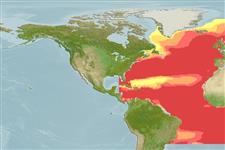Environment: milieu / climate zone / depth range / distribution range
Ekologi
laut batipelagis; kisaran kedalaman 100 - 1800 m (Ref. 87004), usually 100 - 1100 m (Ref. 87004). Subtropical; 75°N - 25°S, 85°W - 0°W
Atlantic Ocean: From Iceland to Brazil and Guinea Gulf, from Caribbean to West Africa.
Size / Weight / umur
Maturity: Lm ? range ? - ? cm
Max length : 11.0 cm SL jantan/; (Ref. 123983)
deskripsi pendek
Kunci identifiaksi (pengenalan) | Morfologi | Morfometrik
Duri punggung (Keseluruhan (total)) : 7 - 8; duri punggung lunak (Keseluruhan (total)) : 10 - 11; Duri dubur: 3; Sirip dubur lunak: 7 - 8; vertebrata, bertulang belakang: 24 - 26. 3 scale rows under the D2 origin down to the lateral line, 10-11 (rarely 12-13) in total. 14-15 pelvic fin rays, rarely 16.
Individuals 7.5 cm SL and longer mostly occur in the boreal areas, while those less than this the length occur in the tropical areas (Ref. 87004). Maximum length reported in Ref. 87004: 11 cm TL.
Life cycle and mating behavior
Maturities | Reproduksi, perkembang biakan | Spawnings | Egg(s) | Fecundities | Larva
Santos, R.S., F.M. Porteiro and J.P. Barreiros, 1997. Marine fishes of the Azores: annotated checklist and bibliography. Bulletin of the University of Azores. Supplement 1. 244 p. (Ref. 35204)
Status IUCN Red List (Ref. 130435)
ancaman kepada manusia
Harmless
penggunaan manusia
Alat, peralatan
laporan khas
muat turun XML
Sumber internet
Estimates based on models
Preferred temperature (Ref.
123201): 1.7 - 18.6, mean 7.7 °C (based on 1396 cells).
Phylogenetic diversity index (Ref.
82804): PD
50 = 0.5176 [Uniqueness, from 0.5 = low to 2.0 = high].
Bayesian length-weight: a=0.01000 (0.00244 - 0.04107), b=3.04 (2.81 - 3.27), in cm total length, based on all LWR estimates for this body shape (Ref.
93245).
Trophic level (Ref.
69278): 3.4 ±0.4 se; based on size and trophs of closest relatives
Daya lenting (Ref.
120179): sedang, Waktu penggandaan populasi minimum 1.4 - 4.4 tahun (Fecundity assumed < 1000).
Fishing Vulnerability (Ref.
59153): Low vulnerability (10 of 100).
